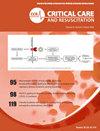Prevalence and characteristics of metaraminol usage in a large intensive care patient cohort. A multicentre, retrospective, observational study
IF 1.7
4区 医学
Q3 CRITICAL CARE MEDICINE
引用次数: 0
Abstract
Background
Noradrenaline is the most prescribed vasopressor in intensive care units (ICUs). Although there is limited supporting evidence, metaraminol is often used as an alternative agent in some regions. We aimed to describe current practice and elucidate the factors associated with metaraminol prescription in a large cohort of ICU patients.
Method
A multicenter, retrospective cohort study of granular, routinely collected electronic medical record–based clinical data was performed in 12 ICUs in Queensland, Australia, between January 1, 2015, and December 31, 2021. Patients who received at least four consecutive hours of either metaraminol or noradrenaline in the first 24 h of their ICU stay were included.
Results
In total, 17,432 patients received single-agent vasopressor therapy and 1,963 (11.3 %) patients were administered metaraminol. For the entire cohort, the median age was 61 (interquartile range, IQR: 47–71), and the median Charlson Comorbidity Index was 3 (IQR: 1–5). The patients who received metaraminol had less ischaemic heart disease (5.5 % vs 7.6 %; p < 0.001) and were more likely to have localised cancer (16 % vs 14 %; p < 0.004). The patients receiving metaraminol were less likely to be ventilated on admission (39 % vs 73 %; p < 0.001) and had lower median Acute Physiology and Chronic Health Evaluation III scores (51 vs 56; p < 0.001). The median duration of metaraminol was 10 h (IQR: 6–18) and two-thirds (65 %) did not convert to noradrenaline infusion. After adjustment for confounders, after-hours admission (odds ratio, OR: 1.55; 95 % confidence interval [CI]: 1.40–1.71; p < 0.001), treatment limitation orders (OR: 1.35; 95 % CI: 1.10–1.64; p < 0.004), and admission to a regional ICU (OR: 1.47; 95 % CI: 1.27–1.68; p < 0.001) were independently associated with metaraminol use.
Conclusion
Metaraminol is a widely used vasoconstrictor in Queensland ICUs. Patients who receive metaraminol have specific characteristics but are overall less unwell than patients who receive noradrenaline. Most patients who receive metaraminol do not require an alternative vasoactive medication.
大型重症监护患者队列中甲氨胺使用的患病率和特点。一项多中心、回顾性、观察性研究
背景:去甲肾上腺素是重症监护病房(icu)最常用的血管加压药物。虽然支持证据有限,但在某些地区,甲氨醇经常被用作替代药物。我们的目的是描述当前的实践,并阐明在ICU患者中与甲氨醇处方相关的因素。方法在2015年1月1日至2021年12月31日期间,对澳大利亚昆士兰州12个icu的颗粒状、常规收集的电子病历临床数据进行多中心、回顾性队列研究。包括在ICU住院的前24小时内接受至少连续4小时的甲氨醇或去甲肾上腺素治疗的患者。结果共17432例患者接受单药血管加压治疗,1963例(11.3%)患者接受甲氨醇治疗。整个队列的中位年龄为61岁(四分位数范围,IQR: 47-71), Charlson合并症指数中位为3 (IQR: 1-5)。接受甲氨醇治疗的患者缺血性心脏病发生率较低(5.5% vs 7.6%;p & lt;0.001),更有可能发生局部癌症(16% vs 14%;p & lt;0.004)。接受甲氨醇治疗的患者入院时不太可能进行通气(39% vs 73%;p & lt;0.001),急性生理和慢性健康评估III评分中位数较低(51比56;p & lt;0.001)。甲氨醇的中位持续时间为10小时(IQR: 6-18),三分之二(65%)未转化为去甲肾上腺素输注。校正混杂因素后,下班后入院(优势比OR: 1.55;95%置信区间[CI]: 1.40-1.71;p & lt;0.001),治疗限制令(OR: 1.35;95% ci: 1.10-1.64;p & lt;0.004),进入地区ICU (OR: 1.47;95% ci: 1.27-1.68;p & lt;0.001)与甲氨醇的使用独立相关。结论甲氨醇是昆士兰icu广泛使用的血管收缩剂。接受甲氨醇治疗的患者有特定的特征,但总体上比接受去甲肾上腺素治疗的患者更少不适。大多数接受甲氨醇治疗的患者不需要另一种血管活性药物。
本文章由计算机程序翻译,如有差异,请以英文原文为准。
求助全文
约1分钟内获得全文
求助全文
来源期刊

Critical Care and Resuscitation
CRITICAL CARE MEDICINE-
CiteScore
7.70
自引率
3.40%
发文量
44
审稿时长
>12 weeks
期刊介绍:
ritical Care and Resuscitation (CC&R) is the official scientific journal of the College of Intensive Care Medicine (CICM). The Journal is a quarterly publication (ISSN 1441-2772) with original articles of scientific and clinical interest in the specialities of Critical Care, Intensive Care, Anaesthesia, Emergency Medicine and related disciplines.
The Journal is received by all Fellows and trainees, along with an increasing number of subscribers from around the world.
The CC&R Journal currently has an impact factor of 3.3, placing it in 8th position in world critical care journals and in first position in the world outside the USA and Europe.
 求助内容:
求助内容: 应助结果提醒方式:
应助结果提醒方式:


